It looks like you're using an Ad Blocker.
Please white-list or disable AboveTopSecret.com in your ad-blocking tool.
Thank you.
Some features of ATS will be disabled while you continue to use an ad-blocker.
share:
I love artifacts of Jiroft, i presented many in my thread Stargates of Iran, i
occasionaly seek out more, and in doing so came across this wonderful example.
This one has got me really puzzled and intrigued;
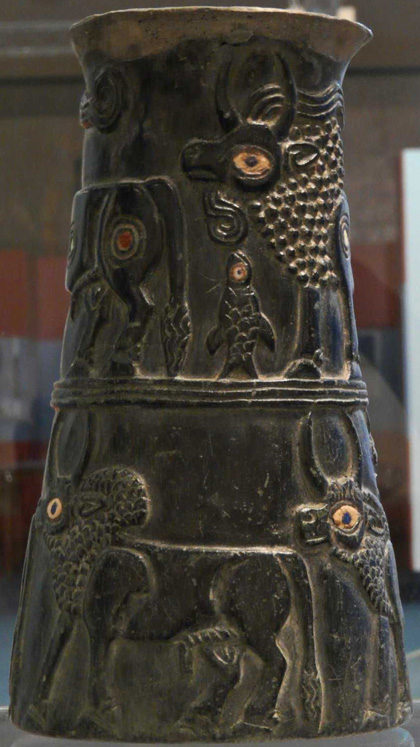
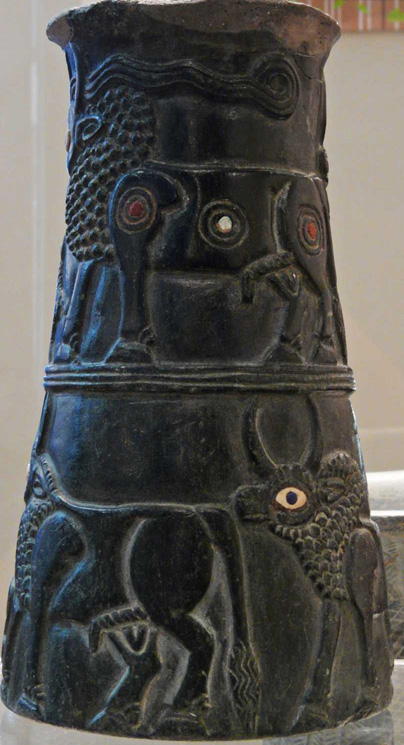
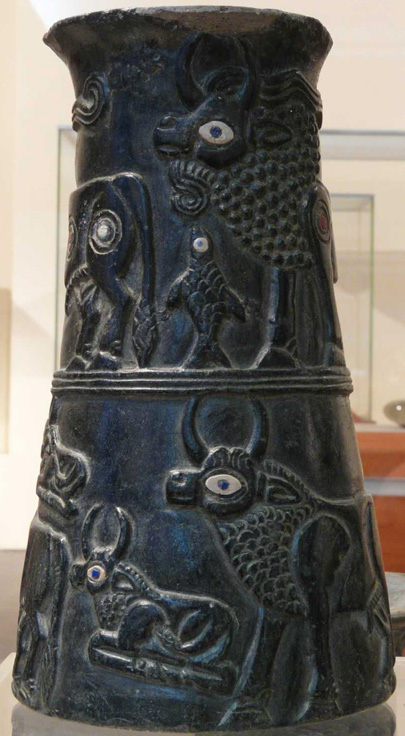
The bulls i would readily identify as representing Taurus, the Bull of Heaven, and i know this can be represented as having three principle stars along its length
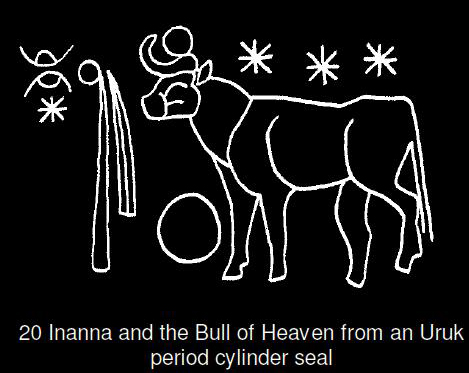
It intrigues me why they would have alternated the two bulls on the upper levels three stars between white and red, but what really mystifies me is the curious upright fish in such a context.
Their interest in the bull of Heaven seen in opposition or mirrored across the East/West horizons i documented, as well as the serpentine means of transition across the portals of the horizon, the fish seems alien in that context as well as an astrological one...

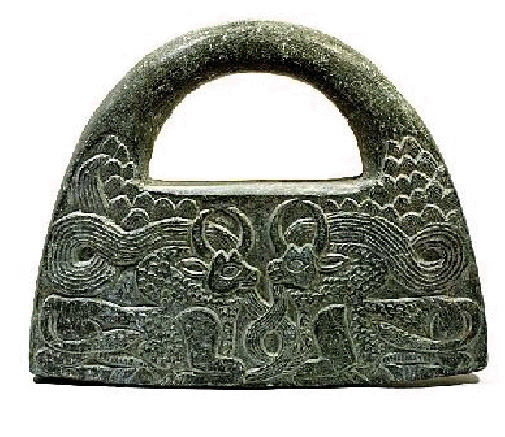
Any thoughts on this alien fish appreciated...it's also the fact that the fish is stood up and there is no suggestion of water that i find a little weird.
This one has got me really puzzled and intrigued;



The bulls i would readily identify as representing Taurus, the Bull of Heaven, and i know this can be represented as having three principle stars along its length

It intrigues me why they would have alternated the two bulls on the upper levels three stars between white and red, but what really mystifies me is the curious upright fish in such a context.
Their interest in the bull of Heaven seen in opposition or mirrored across the East/West horizons i documented, as well as the serpentine means of transition across the portals of the horizon, the fish seems alien in that context as well as an astrological one...


Any thoughts on this alien fish appreciated...it's also the fact that the fish is stood up and there is no suggestion of water that i find a little weird.
edit on 22-12-2012 by Kantzveldt because: (no reason given)
Great pics S&F
Dont mean to be a stick in the mud but to me it just looks like a stylised fish, sorry.
You mention the bulls may be a representation of Taurus, could the fish be Aquarius?
In the 2nd pic does it look to anyone else like someone is giving the bull on the bottom left ah... ahem.... a hand LOL
Dont mean to be a stick in the mud but to me it just looks like a stylised fish, sorry.
You mention the bulls may be a representation of Taurus, could the fish be Aquarius?
In the 2nd pic does it look to anyone else like someone is giving the bull on the bottom left ah... ahem.... a hand LOL
edit on 22/12/2012 by
IkNOwSTuff because: (no reason given)
reply to post by IkNOwSTuff
It just looks like a stylized fish to me also, it's the context that is 'alien', in that no it really can't be Pisces or Aquarius, the Sumerians and probably the Proto-Elamites had an entire region of the cosmos that was related to aquatics, including the Abzu, fishes, water Deities, but that is not near Taurus.

A seal i found that might help though is this...
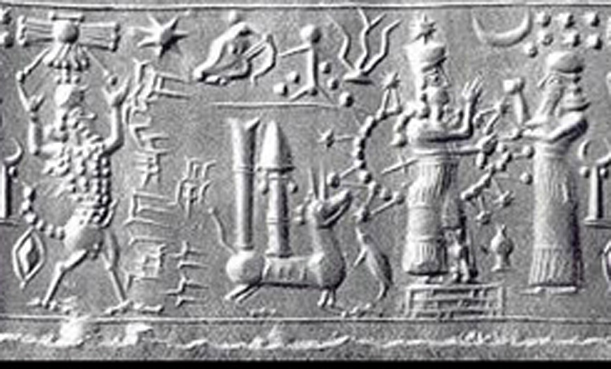
One thing i am wondering, given my interest in the Mayans depiction of the belt stars of Orion with the turtle, www.abovetopsecret.com... is could that be a turtle rather than a fish..?!?..the seal example indicates maybe.
It just looks like a stylized fish to me also, it's the context that is 'alien', in that no it really can't be Pisces or Aquarius, the Sumerians and probably the Proto-Elamites had an entire region of the cosmos that was related to aquatics, including the Abzu, fishes, water Deities, but that is not near Taurus.

A seal i found that might help though is this...

One thing i am wondering, given my interest in the Mayans depiction of the belt stars of Orion with the turtle, www.abovetopsecret.com... is could that be a turtle rather than a fish..?!?..the seal example indicates maybe.
edit on 22-12-2012 by Kantzveldt because: (no reason given)
Hi Kantz, good thread you got here. About the "standin fish" without water, it seems to be an ancient christian symbol.
Maybe that object represents a prophecy ?......or the sysmbol was adopted by first christians. I don't know, but it's interesting.....
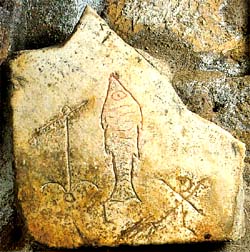
www.jesuswalk.com...
Maybe that object represents a prophecy ?......or the sysmbol was adopted by first christians. I don't know, but it's interesting.....

www.jesuswalk.com...
edit on 22-12-2012 by Trueman because: (no reason given)
I'm thinking more along the lines of the fish god Dagon. He is often represented as upright. Though usually as human and fish. I've often wondered if
the early "Christian" use of the fish was actually code for those among the faith who still secretly belonged to the Dagon cult. At least in the
beginning.
ETA: Dagon with a Bandaddu, and that mysterious cone(unseen) seen in the hand of so many gods from the era.
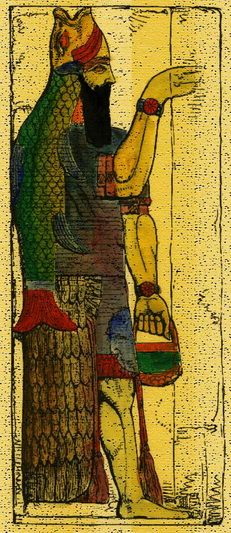
Just a thought. It could be just what it looks like. A fish.
edit on 12/22/2012 by Klassified because: (no reason given)
ETA: Dagon with a Bandaddu, and that mysterious cone(unseen) seen in the hand of so many gods from the era.

Just a thought. It could be just what it looks like. A fish.
edit on 12/22/2012 by Klassified because: eta
reply to post by Trueman
It certainly looks just like that, a standing up fish, weird they placed it in conjuction with a bull, unless it represents the Hyades
reply to post by Klassified
Yes the fish God representations are an oddity, one might expect some correspondance to the Abzu and Pisces, Aquarius constellations, but maybe there was some sort of Fish God associated with Taurus and the Hyades, traditionaly related to bringing rain.
It certainly looks just like that, a standing up fish, weird they placed it in conjuction with a bull, unless it represents the Hyades
reply to post by Klassified
Yes the fish God representations are an oddity, one might expect some correspondance to the Abzu and Pisces, Aquarius constellations, but maybe there was some sort of Fish God associated with Taurus and the Hyades, traditionaly related to bringing rain.
edit on 22-12-2012 by Kantzveldt because: (no reason given)
reply to post by Klassified
The mystery cone represents the pineal gland, at least from everything I have read. The gland actually resembles the pinecone in appearance. Another interesting link is the egyptian eye mimics the inner brain with the eye centered around the gland.
The mystery cone represents the pineal gland, at least from everything I have read. The gland actually resembles the pinecone in appearance. Another interesting link is the egyptian eye mimics the inner brain with the eye centered around the gland.
edit on 22-12-2012 by ParanoidAmerican
because: (no reason given)
edit on
22-12-2012 by ParanoidAmerican because: (no reason given)
edit on 22-12-2012 by ParanoidAmerican because: (no reason
given)
edit on 22-12-2012 by ParanoidAmerican because: (no reason given)
Originally posted by ParanoidAmerican
reply to post by Klassified
The mystery cone represents the pineal gland, at least from everything I have read. The gland actually resembles the pinecone in appearance. Another interesting link is the egyptian eye mimics the inner brain with the eye centered around the gland.edit on 22-12-2012 by ParanoidAmerican because: (no reason given)
Correct sir. Well said.
I sometimes refer to it as the mystery cone, because I think we're missing a piece of the puzzle regarding it. I'm not sure what it is yet, but I'm working on it.
edit on 12/22/2012 by Klassified because: (no reason given)
from its posture and 'fins' sticking out...to me it looks like a penguin.
I don't much associate Iran with fish (or penguins for that matter)
I don't much associate Iran with fish (or penguins for that matter)
reply to post by Klassified
Have you read anything about the association between the pineal gland and '___'?
'___': The Spirit Molecule
If you have never heard of this book, it is definitely worth a read.
I sometimes refer to it as the mystery cone, because I think we're missing a piece of the puzzle regarding it. I'm not sure what it is yet, but I'm working on it.
Have you read anything about the association between the pineal gland and '___'?
'___': The Spirit Molecule
In 1990, I [Strassman] began the first new human research with psychedelic, or hallucinogenic, drugs in the United States in over 20 years. These studies investigated the effects of N,N-dimethyltryptamine, or '___', an extremely short-acting and powerful psychedelic. During the project's five years, I administered approximately 400 doses of '___' to 60 human volunteers. This research took place at the University of New Mexico's School of Medicine in Albuquerque, where I was a tenured Associate Professor of Psychiatry.
If you have never heard of this book, it is definitely worth a read.
edit on 22-12-2012 by LewsTherinThelamon because: (no reason
given)
reply to post by Kantzveldt
In some asiatic cultures the fish is sometimes used as provider of water.
In many cases the fish is used as a symbol to provide water to scare away fire spirits.
Sometimes referred to "Shachihoko" - "Dragon Fish" or "Tiger Fish"
japandave.com...
en.wikipedia.org...
Images
www.google.com.au...
Just like gothic churches used gargoyles to scare away evil spirits.
I know this one stands on it's head, but I just want to show the fish was a symbol of water without having to have the presence of water shown.
Also sometimes a fish is a symbol of
fertility
eternity
creativity
femininity
good luck
happiness
knowledge
transformation
www.whats-your-sign.com...
Hope this provides some ideas.
Regards.
In some asiatic cultures the fish is sometimes used as provider of water.
In many cases the fish is used as a symbol to provide water to scare away fire spirits.
Sometimes referred to "Shachihoko" - "Dragon Fish" or "Tiger Fish"
japandave.com...
With their magical dragon fish powers, they protect the castle from harm!
Well, from fire anyways. Or so the story goes. A shachihoko is a mythical beast with the head of a dragon and the body of a carp. It has the power to cause rain to fall. Because of this, the old Japanese stuck this guy on castles and other important structures to protect them from fire.
It’s a rather indirect way to protect from fire, but you can see the reasoning here.
en.wikipedia.org...
A shachihoko (鯱?) is an animal in Japanese folklore with the head of a tiger and the body of a carp. It was believed that this animal could cause the rain to fall, and as such, temples and castles were often adorned with roof ornaments (shibi) crafted in the form of a shachihoko, in order to protect them from fire.
Images
www.google.com.au...
Just like gothic churches used gargoyles to scare away evil spirits.
I know this one stands on it's head, but I just want to show the fish was a symbol of water without having to have the presence of water shown.
Also sometimes a fish is a symbol of
fertility
eternity
creativity
femininity
good luck
happiness
knowledge
transformation
www.whats-your-sign.com...
To fully appreciate the symbolic meanings of fish, we must first consider their watery domain.
Water holds ancient symbolic meanings dealing with the subconscious and depth of knowledge. Water contains all the mysteriousness of the unknown.
Consider the murky depths of the ocean – we never know quite what to expect there. Even seasoned oceanic explorers are still awed by their findings from the deep.
Water holds endless mystery to us – it represents that which is certainly there, but cannot be seen.
Water has also been known to be a womb symbol and as such, an emblem of birth, fertility and woman-ness. This association comes from many ancient flood myths, and the “from water springs life” concept.
Given the wonder that its domain holds, the fish too has similar symbolic meaning. There are numerous species of fish, but the creature in general holds some prime symbolic meanings:
fertility
eternity
creativity
femininity
good luck
happiness
knowledge
transformation
The fish was sacred to the Greco-Roman mythology, where it held symbolic meaning of change and transformation. We see this in the myth of Aphrodite and Heros when they turned themselves into fish in order to escape from the ferocious Typhon.
In Christianity, the fish is a symbol of abundance and faith as observed in the Biblical story of fishes and loaves. There are also several Biblical references as Christ and his disciples being “fishers of men.” Here, man is represented as the transformational fish and the ocean is a symbol of the abyss of sin in which man finds himself.
Pagan traditions recognized the fish as a feminine symbol of fertility and an attribute of the Goddess. Water is a natural emblem of the flow of the Divine Mother principal, and as such, all creatures of the water (including fish) are aspects of the fertility and power of the female deity.
As an ancient Celtic symbol, the symbolic meaning of fish (salmon, specifically) dealt with knowledge, wisdom, inspiration and prophecy. Ancient Celts believed the salmon derived its wisdom from consuming the sacred hazel nuts from the well of knowledge (Segais). Further, they believed to eat the salmon would mean gaining the wisdom of the well too.
In ancient Eastern Indian mythology, the fish is a symbol of transformation and creation. This is observed in the ancient flood myth in which Vishnu transformed himself into a fish (Matsya) to save the world from a great flood. In this form, he guided king Manu’s boat (which contained the select few survivors & seeds of life to re-create the world after the flood subsided) to safety.
Ancient African creation myths tell of Mangala, the creator, planting seeds in the cosmic womb. From these seeds two fish erupted, and were set forth into the cosmos upon the waters of creation. We see from this myth the symbolic meaning of fish yet again deals with fertility and creativity by embodying a new phase of initial life.
In China, the fish is symbolic of unity and fidelity as it is noted that fish (particularly koi) often swim together in pairs. With this in mind, fish are often given as wedding gifts in the form of charms or figurines to present the newly-wed couple with an auspicious sign of fidelity and perfect union. They also represent fertility and abundance due to their ability to reproduce in speed and volume.
Furthermore, in Buddhism, the fish symbolizes happiness and freedom. Also the fish makes an appearance as one of the eight sacred symbols of the Buddha: 1) Conch, 2) Lotus, 3) Parasol, 4) Wheel, 5) Knot, 6) Pair of Golden Fish, 7) Banner of Victory, 8) Vase.
Lastly, in Norse and ancient European cultures, the fish had symbolic meanings of adaptability, determination, and the flow of life. It was observed by these cultures that fish often display enormous attributes of adaptability in the wild, and they adopted these characteristics for themselves. Salmon were commonly revered for their determination in their annual pilgrimage to their spawning grounds – the entire journey swum against the current.
Hope this provides some ideas.
Regards.
edit on 22-12-2012 by acrux because: (no reason given)
reply to post by LewsTherinThelamon
Yes. I'm familiar with it. Wild stuff there, eh? The piece of the puzzle I was thinking of was more along the lines of historical references. Where ever we find a figure holding this cone, we know we're dealing with priests, divinity, and gods. You won't find a commoner holding this little gem, or a bandaddu either. Also, the cone always seems to be held as you see in the image above. There's more here than meets the eye. It's something that's in my long list of things to research, I just can't seem to get to all of the stuff I want to dig into.
Thanks for the recommendations too.
Have you read anything about the association between the pineal gland and '___'?
Yes. I'm familiar with it. Wild stuff there, eh? The piece of the puzzle I was thinking of was more along the lines of historical references. Where ever we find a figure holding this cone, we know we're dealing with priests, divinity, and gods. You won't find a commoner holding this little gem, or a bandaddu either. Also, the cone always seems to be held as you see in the image above. There's more here than meets the eye. It's something that's in my long list of things to research, I just can't seem to get to all of the stuff I want to dig into.
Thanks for the recommendations too.
reply to post by Kantzveldt
Thanks for those pics of a distant age. I really enjoy looking at them. I don't really know their "deep meaning". Now a days we have print and computers. Its so easy to tell a tale or message someone.
My guess is that the people that make these mugs with "murals" on them are telling a story of someone. In rough form these "pictograms" may just be that.
" I am Korg. I raise cattle, catch fish and I have fought snakes and lions. This on his mug at the local "watering hole".
Everyone in town knows him and his craft. To think that thousands of years later we do too is just well, mind blowing. Imagine what he would say if he knew his mug was splashed onto millions of computers.
If he was here today he would raise his mug, point at his chest and shout, "I am Korg! I raise cattle, fight sna---"
Yah yah. Alright buddy we know, sit down.
If in doubt about the stylized nature of peoples roles and their imagined greatness, just look at some avatars on a site called ATS.
Thanks for those pics of a distant age. I really enjoy looking at them. I don't really know their "deep meaning". Now a days we have print and computers. Its so easy to tell a tale or message someone.
My guess is that the people that make these mugs with "murals" on them are telling a story of someone. In rough form these "pictograms" may just be that.
" I am Korg. I raise cattle, catch fish and I have fought snakes and lions. This on his mug at the local "watering hole".
Everyone in town knows him and his craft. To think that thousands of years later we do too is just well, mind blowing. Imagine what he would say if he knew his mug was splashed onto millions of computers.
If he was here today he would raise his mug, point at his chest and shout, "I am Korg! I raise cattle, fight sna---"
Yah yah. Alright buddy we know, sit down.
If in doubt about the stylized nature of peoples roles and their imagined greatness, just look at some avatars on a site called ATS.
Originally posted by Klassified
I'm thinking more along the lines of the fish god Dagon. He is often represented as upright. Though usually as human and fish. I've often wondered if the early "Christian" use of the fish was actually code for those among the faith who still secretly belonged to the Dagon cult. At least in the beginning.edit on 12/22/2012 by Klassified because: (no reason given)
ETA: Dagon with a Bandaddu, and that mysterious cone(unseen) seen in the hand of so many gods from the era.
That pic is of Adapa/Oannes, the first Apkallu (sage) sent from heaven to help mankind.
I realize that several websites claim that Dagon is the Philistine version of OannesAdapa (Oannes was the way Berossus wrote the name Uanna/Uan, which was a name given to Adapa in some texts found in the Library of Ashurbanipal, last great king of the Assyrians.) But Dagon, as Dagan, was another Sumerian diety at the same time as Adapa. IOW, Adapa and Oannes may be referring to the same being, but Dagon is a different being than these two.
Only the Apkallu are associated with the "pinecone and bucket" iconography,
EDIT: That particular pic of Uanna appears to be Assyrian.
Harte
edit on 12/23/2012 by Harte because: (no reason given)
reply to post by Klassified
Here.s a bowl with twin bulls, sacred mountain of the horizon, with sacred pine tree growing on it. The similar stylistic rendering of the mountain and cones interests me, this would also carry over with regards to fish scales.
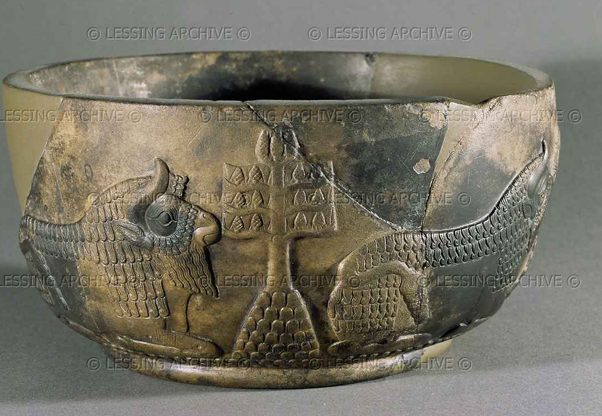
reply to post by acrux
Yes it does provide food for thought, thanks. My research indicates that Taurus was an important intersection point in cosmological terms, regarding the ecliptic and galactic planes, a portal on the horizon giving connectivity between Earth, the Heavens and the Underworld.
As the cosmos was seen as 'watery' it's possible the fish symbol associated with this locale provided a means of transition through the watery medium, generally Deities hop on a boat when engaging in these journeys but i guess fish transformation was another option.
If one looks at the original vase image you can see the serpentine/watery motif rising from above the fish .
Here.s a bowl with twin bulls, sacred mountain of the horizon, with sacred pine tree growing on it. The similar stylistic rendering of the mountain and cones interests me, this would also carry over with regards to fish scales.

reply to post by acrux
Yes it does provide food for thought, thanks. My research indicates that Taurus was an important intersection point in cosmological terms, regarding the ecliptic and galactic planes, a portal on the horizon giving connectivity between Earth, the Heavens and the Underworld.
As the cosmos was seen as 'watery' it's possible the fish symbol associated with this locale provided a means of transition through the watery medium, generally Deities hop on a boat when engaging in these journeys but i guess fish transformation was another option.
If one looks at the original vase image you can see the serpentine/watery motif rising from above the fish .
edit on 23-12-2012 by Kantzveldt
because: (no reason given)
reply to post by Harte
Thanks for the great info Harte. That's what I get for not paying attention to which one I'm grabbing in a quick image search.
Thanks for the great info Harte. That's what I get for not paying attention to which one I'm grabbing in a quick image search.
reply to post by Kantzveldt
Interesting. I thought it was that the bull had a beard, like a goat. Maybe water though...or watery space. The first thing I noticed is that the fish was directly under the mouth or head of the bull. Then the second thing was that the other bull did not have a fish under its head. I don't know if there is any significance to these two things I noticed, but perhaps you may be able to remember some connection with the fish being on the left/right or east/west facing side, or maybe we can see if there is anything else different about the bulls. Why only one fish? Why only on one side? Is there something special about that side?
I see now that the cone is a "pine cone", but at first when it was "not shown here", I thought of a pile of monoatomic gold.
Thanks for showing me some old stuff. I love old stuff. Peace.
Interesting. I thought it was that the bull had a beard, like a goat. Maybe water though...or watery space. The first thing I noticed is that the fish was directly under the mouth or head of the bull. Then the second thing was that the other bull did not have a fish under its head. I don't know if there is any significance to these two things I noticed, but perhaps you may be able to remember some connection with the fish being on the left/right or east/west facing side, or maybe we can see if there is anything else different about the bulls. Why only one fish? Why only on one side? Is there something special about that side?
I see now that the cone is a "pine cone", but at first when it was "not shown here", I thought of a pile of monoatomic gold.
Thanks for showing me some old stuff. I love old stuff. Peace.
new topics
-
Not off to a good start
General Chit Chat: 1 hours ago -
If they can see...they can read!!
Rant: 8 hours ago
top topics
-
Tesla Cybertruck Explodes in Front of Trump Hotel in Las Vegas
Mainstream News: 14 hours ago, 19 flags -
If they can see...they can read!!
Rant: 8 hours ago, 6 flags -
Maybe they didn't get away with it: The Lincoln-Kennedy assassination parallels. 7 sentences long.
History: 16 hours ago, 4 flags -
Not off to a good start
General Chit Chat: 1 hours ago, 1 flags
active topics
-
If they can see...they can read!!
Rant • 7 • : AlroyFarms -
DONALD J. TRUMP - TIME's Most Extraordinary Person of the Year 2024.
Mainstream News • 43 • : Imhere -
Not off to a good start
General Chit Chat • 2 • : DAVID64 -
How we've changed in 100 years
Ancient & Lost Civilizations • 19 • : Flyingclaydisk -
Tesla Cybertruck Explodes in Front of Trump Hotel in Las Vegas
Mainstream News • 58 • : Flyingclaydisk -
Vehicle Strikes people in New Orleans
Mainstream News • 246 • : Flyingclaydisk -
Mood Music Part VI
Music • 3774 • : Hellmutt -
SCOTUS Chief Justice JOHN ROBERTS Ends 2024 Describing His Fears for Safety of U.S. Judges.
Above Politics • 11 • : WeMustCare -
-@TH3WH17ERABB17- -Q- ---TIME TO SHOW THE WORLD--- -Part- --44--
Dissecting Disinformation • 3880 • : WeMustCare -
NYPD arrests migrant who allegedly set woman on fire on subway train, watched her burn to death
Breaking Alternative News • 60 • : WeMustCare
